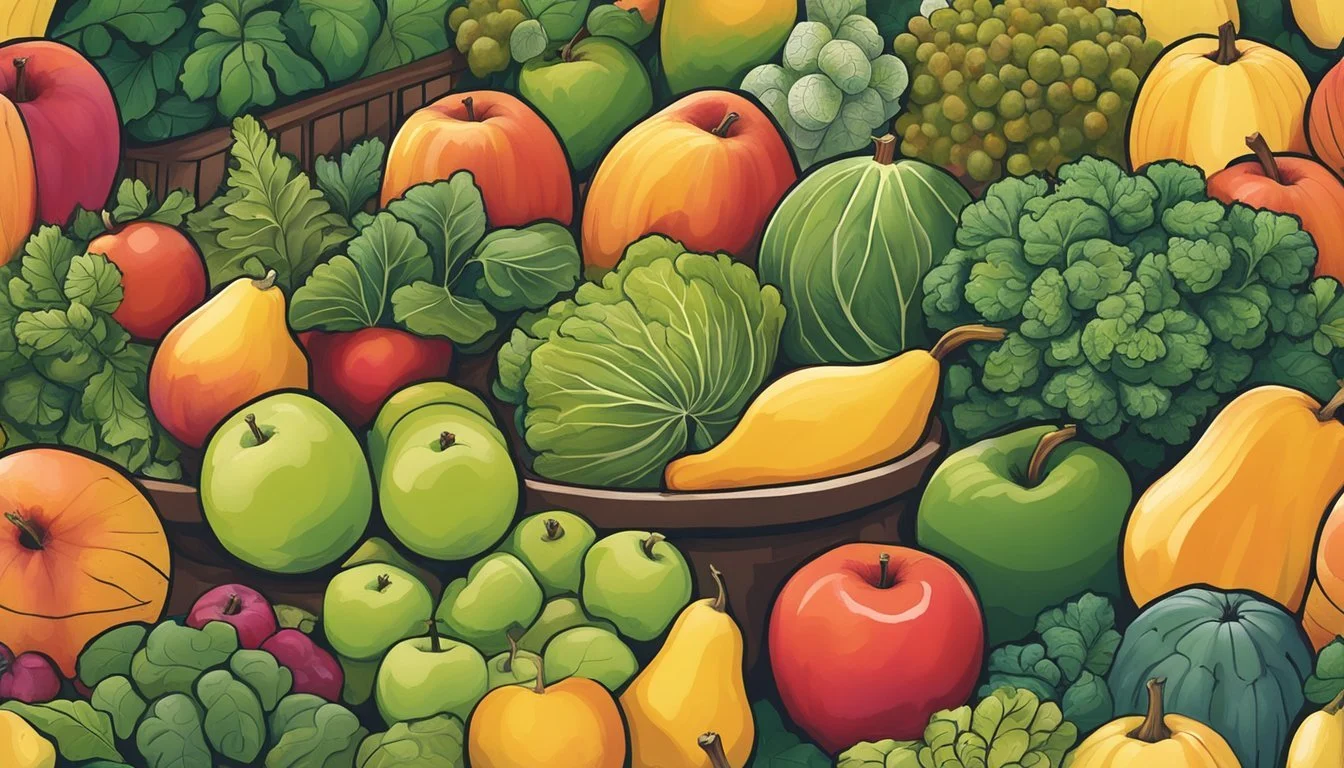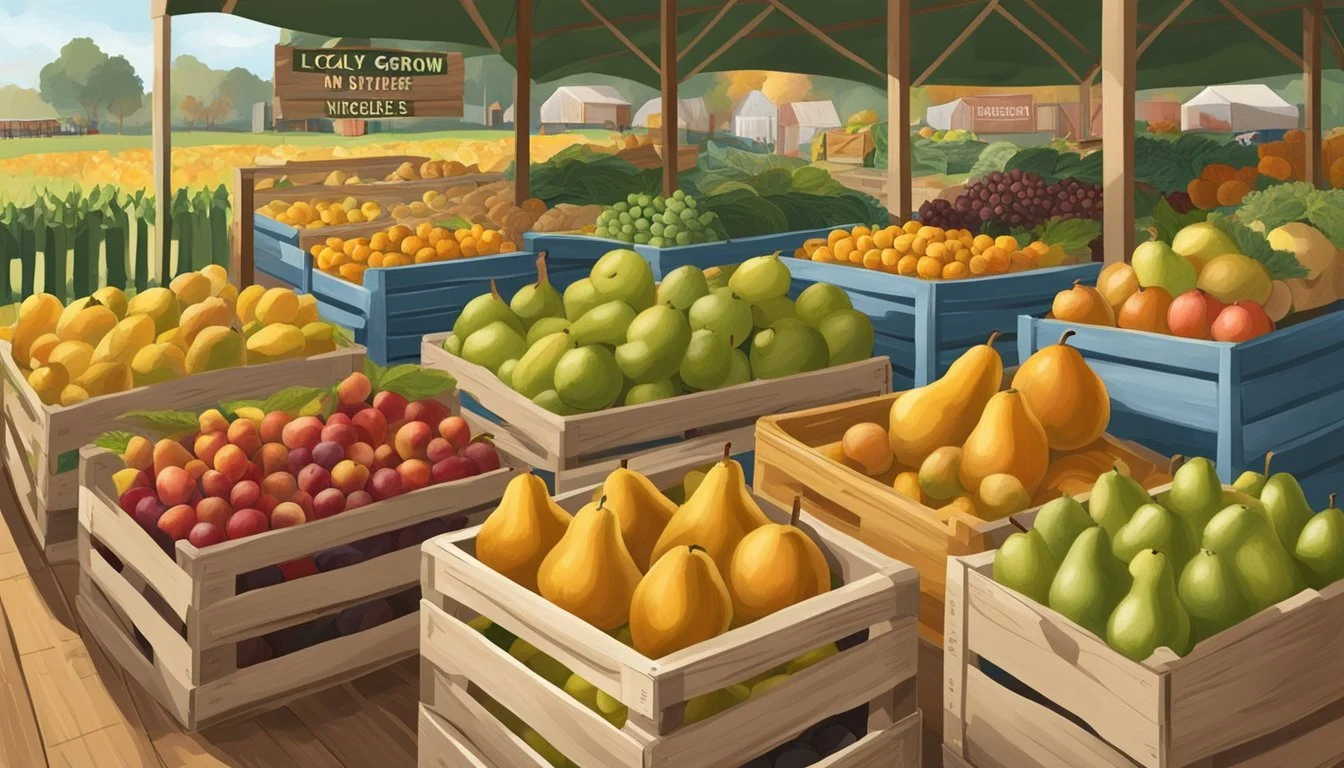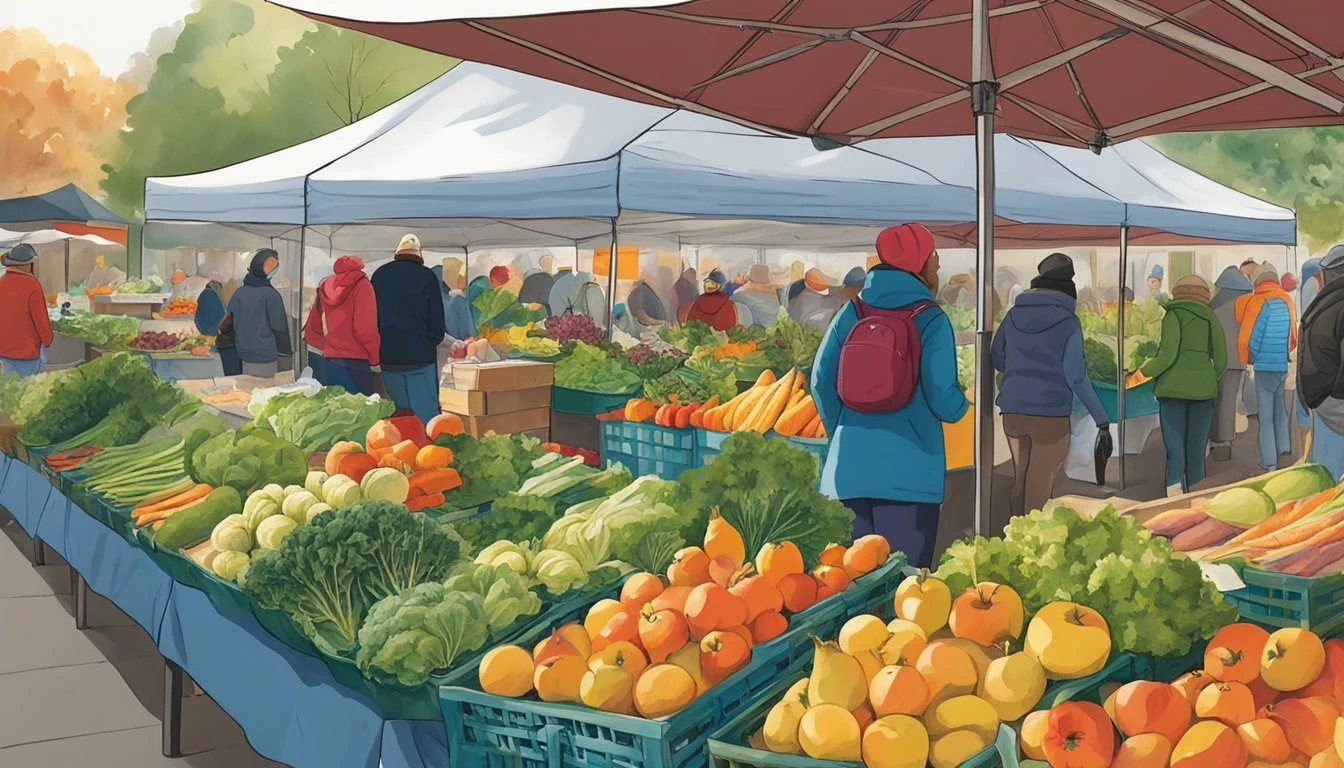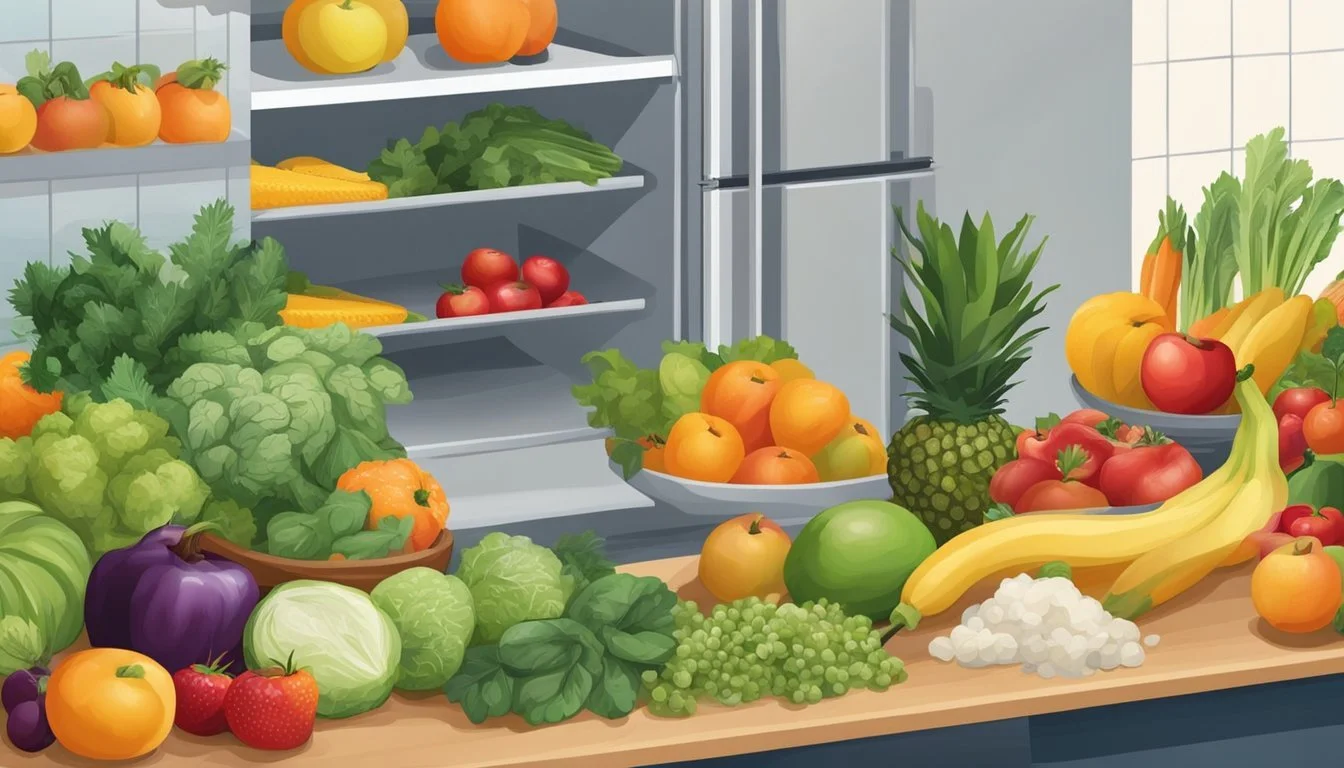Maryland Seasonal Fruit & Vegetables in December
Your Fresh Guide
This Article is Part of our Maryland Seasonal Fruit & Veg Calendar
In Maryland, December marks a unique period characterized by shorter days and colder temperatures, which naturally impacts the availability of fresh produce. Despite these seasonal changes, there is still an array of fruits and vegetables that can be harvested during this winter month. These seasonal offerings not only promise freshness but also align with sustainable eating practices by favoring produce that naturally grows during this time of the year.
Farmers in the region adapt to the chill of December by focusing on crops that can withstand the frosty weather. Root vegetables like beets and carrots (how long do carrots last?) continue to thrive and are often available, thanks to their ability to be stored well after being harvested in the earlier fall months. Greens such as cabbage and Brussels sprouts (how long do brussels sprouts last?)are also typical due to their hardiness in cooler temperatures.
Apples (how long do apples last?), one of Maryland's durable staples, remain in supply through cold storage well into the winter months. These fruits, along with stored crops such as potatoes and onions, contribute to the variety of produce that can still be enjoyed. Therefore, even as the winter sets in, Maryland’s residents and culinary enthusiasts can take advantage of the seasonal fruits and vegetables that December has to offer.
Overview of Maryland's Seasonal Produce
Maryland's December brings a limited but valuable range of fruits and vegetables. They sustain local traditions and emphasize the benefits of seasonal consumption.
Winter Harvest Traditions
In Maryland, winter is a time of seasonally specific harvests that offer a taste of local tradition through a variety of crops that thrive in the colder months. Though fruit options are limited, one can savor the last of the fall harvests, such as apples, which remain crisp and delicious into early winter, reflecting December's capability to yield fresh produce.
Importance of Seasonal Eating
Seasonal eating in December supports local Maryland farmers and reduces the carbon footprint associated with importing non-seasonal produce. It brings to the table produce like beets and turnips, which are among the robust vegetables that withstand the chill, offering both freshness and a hearty flavor profile appropriate for winter's comfort meals.
December's Unique Planting Calendar
Maryland's planting calendar in December is generally at a rest, yet some hardy vegetables are sown in preparation for early spring. Gardeners and farmers often look ahead, using the month to plan and prepare the soil for crops like peas and spinach, which are some of the first to be planted in the cool early months of the new year, indicating Maryland's cyclical agricultural agenda.
Seasonal Vegetables in December
In December, Maryland's chill ushers in an abundance of nutrient-rich vegetables suited to colder weather. Root vegetables and tubers are prime for harvest, alongside hearty greens and various cruciferous vegetables, each offering robust flavors and health benefits.
Root Vegetables and Tubers
Root vegetables and tubers thrive in the region's wintery conditions. Potatoes stand out as a versatile staple, with varieties ready to be dug up and enjoyed. Carrots and beets, both known for their natural sweetness and high vitamin content, are also in season, reaching peak flavor during the colder months. Similarly, turnips offer a pungent, slightly bitter taste and can be roasted, mashed, or added to stews.
Potatoes: Versatile and hearty, good for roasting, boiling, or mashing.
Carrots: Sweet and rich in beta-carotene, ideal for salads, soups, and roasting.
Beets: Earthy flavor, available in multiple colors, used in salads, soups, or pickled.
Turnips: Sharp taste, can be used as a potato substitute or in mixed vegetable dishes.
Hearty Greens
The chill of winter allows for the flourishing of kale, a leafy green packed with nutrients such as vitamins A, C, and K. It can be used in a multitude of dishes ranging from crispy chips to sautéed sides. Hearty greens withstand colder temperatures, often becoming sweeter after a frost.
Kale: Nutrient-dense, with a slightly peppery taste, excellent in salads or as a cooked green.
Cruciferous Vegetables
Cruciferous vegetables, defined by their cross-shaped flowers, are perfect for December harvests. Maryland gardens yield a bounty of these, including brussels sprouts and various types of cabbage that can be prepared in diverse ways, from roasting to fermenting.
Brussels sprouts: Best when roasted, revealing a caramelized, nutty flavor.
Cabbage: Ideal for slaws, sauerkraut, or stewed dishes (What wine goes well with stewed dishes?).
Root vegetables and hearty greens can be found at local Maryland farmers markets, often grown in sustainable and organic practices that ensure peak freshness and flavor for December meals.
Seasonal Fruits in December
December in Maryland sees fewer fruits in season, but certain varieties remain available and are celebrated for their fresh, crisp flavors during the colder months.
Citrus and Pomes
December marks a period where the sweetness and acidity of citrus fruits come to the forefront in Maryland. Shoppers can find oranges and clementines which are usually at their juicy best.
Oranges: Ideal for juicing or eating fresh.
Clementines: Smaller and sweeter, perfect for on-the-go snacking.
Pomes, specifically apples and pears, maintain their presence in the market, thanks to their late-season varieties and cold storage.
Apples: Varieties such as Fuji and Granny Smith can be found.
Pears: Look for winter varieties like Anjou or Bosc.
Winter Berries
While berries are generally associated with summer, some hardy varieties persist. However, it is important to note that in Maryland, fresh local berries are not typically found in December and would likely be imports as the local berry season ends before winter.
Locally Grown and Stored Produce
In Maryland, December marks a time where the availability of fresh produce shifts towards those crops that are able to be stored longer and withstand the colder temperatures. Consumers can find a variety of squashes and gourds, as well as an assortment of cold storage crops at local markets.
Squashes and Gourds
Squashes and gourds are mainstays of the December produce lineup in Maryland. These vegetables are harvested in the fall and store well through the colder months, making them a reliable option for local consumption.
Squash: Varieties like butternut, acorn, and spaghetti squash are often available.
Pumpkin: Beyond its decorative use, pumpkins are versatile in many recipes, from soups to pies.
Winter Squash: Includes the aforementioned varieties and others such as Hubbard and delicata, known for their rich flavors and hearty textures.
Cold Storage Crops
Certain root vegetables and tubers are harvested before the frost and kept in cold storage to extend their availability into the winter months. These crops retain their quality and nutritional value when stored properly.
Sweet Potatoes: Sweet potatoes can be found in abundance, given their ability to be stored effectively.
These selections not only support local agriculture but also provide nutritious options for winter meals.
Maryland's Farmers Markets in December
Despite the chilly weather, December in Maryland still offers an array of local produce at farmers markets. They serve as hubs for seasonal shopping and support local agriculture.
Market Availability
In December, Maryland's farmers markets transition to cater to the colder climate. However, they maintain a diverse selection of produce. The markets typically operate on a scaled-back schedule due to the season, yet shoppers can find:
Vegetables: Beets, Brussels Sprouts, Cabbage
Fruits: Limited due to the cold climate, but sometimes storage crops like apples are available
Tip: Market hours may be reduced in winter. It's recommended to check the schedule of local markets online before visiting.
Shopping Tips for Seasonal Selections
When shopping at Maryland's farmers markets in December, it's essential to come prepared for a different experience than the summer months.
Dress Appropriately: The weather can be brisk; warm clothing is advised.
Storage Crops: Look for root vegetables and hearty greens that store well in colder months.
Plan Ahead: Inventory can be limited, so it’s good practice to arrive early for the best selection.
Ask Vendors: They can provide information on how to store and prepare seasonal items.
Remember, supporting local markets during this time of year is crucial for the livelihood of farmers and the sustainability of local agriculture.
Cooking and Storing Tips for December Produce
December in Maryland brings a bounty of produce that can be transformed into hearty stews and refreshing salads. Proper preparation and storage are key to maximizing flavor and longevity.
Preparation of Root Vegetables
Root vegetables such as beets and carrots are staples in December. They thrive in the cold and can be quite versatile in the kitchen. Here's how to prepare them:
Beets: Scrub the skin thoroughly to remove dirt. They can be roasted whole or diced for a quicker cooking time.
Carrots: Peel or scrub well before using. Carrots can be left whole for roasting or sliced for stews and salads.
Cooking root vegetables can intensify their natural sugars, especially when roasted, making them a delicious addition to the winter table.
Storing for Freshness
Proper storage is essential to retaining the freshness of December produce. Here are guidelines for common vegetables:
Beets: Store in a cool, dark place with high humidity, ideally in the vegetable drawer of your refrigerator.
Brussels Sprouts: Keep in a plastic bag in the crisper drawer but consume within a week for optimal freshness.
Cabbage: Wrap tightly in plastic and refrigerate. It can last for several weeks when stored properly.
Incorporating these vegetables into dishes like stews can extend the enjoyment of your December harvest, as many stews freeze well and can make quick, nourishing meals on cold days.
Benefits of Eating Seasonally in Maryland
Eating seasonally in Maryland provides several advantages that include heightened nutritional content, reduced environmental impact, and bolstered local economies. These aspects make seasonal eating a health-conscious, eco-friendly, and community-supportive choice for Maryland residents.
Nutritional Advantages
Seasonal fruits and vegetables grown and harvested in their optimal conditions often contain an abundance of nutrients. For instance, beets, which are available from June through December in Maryland, are a great source of fiber, folate, and vitamin C when eaten at their freshest. Additionally, winter squashes, picked in their peak season, offer higher concentrations of vitamins and antioxidants.
Environmental Impact
Locally-sourced seasonal produce reduces the need for long-distance transportation. This decrease in food miles helps in lowering greenhouse gas emissions and preserving the quality and flavor of the produce. Consuming fruits and vegetables, like Maryland's winter harvested kale, when they naturally grow in the area supports sustainable farming practices and reduces the environmental footprint.
Supporting Local Economy
Purchasing from local Maryland farmers and growers means the money stays within the community, fostering economic growth. Local farmers' markets and community-supported agriculture (CSA) programs offer seasonal selections that ensure freshness and support producers directly. This cycle creates and maintains jobs within the region and contributes to a robust local economy.









